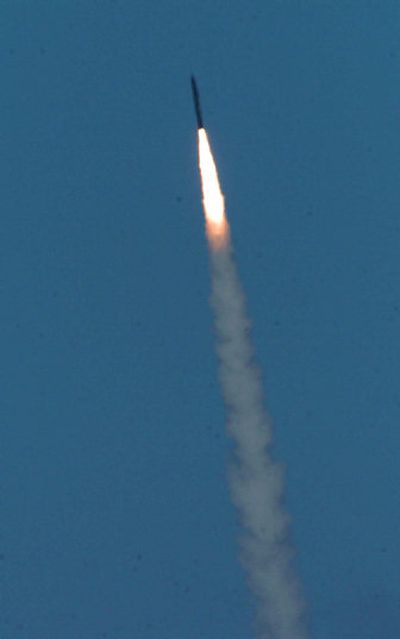Military hits target missile in defense test

WASHINGTON – The U.S. military successfully shot down a target missile using its long-range missile defense system Friday, the first time such a test has intercepted a mock enemy warhead since 2002, officials said.
An interceptor missile was launched from Vandenberg Air Force Base in California and collided with its target more than 100 miles above the Earth, according to the Missile Defense Agency. The target, launched from Alaska, was the first to provide a trajectory similar to the path a missile fired from North Korea might follow in an attack on West Coast cities.
Pentagon officials hailed the test as a major step forward for the nation’s “shield” against incoming ballistic missiles, saying it vindicates their confidence in the military’s ability to thwart an overseas launch of a missile carrying weapons of mass destruction.
But experts cautioned that the test lacked some real-world conditions, such as enemy efforts to defeat the missile defense system, a surprise attack and an attack involving multiple missiles. They said it does not yet indicate the nation is secure from a missile attack.
Air Force Lt. Gen. Henry “Trey” Obering III, director of the Missile Defense Agency, said Friday that he believes the U.S. would have “a good chance” of shooting down a missile that threatened the United States with a system that “would be very capable” if it had to be used today. He said the U.S. had tried to mimic North Korea’s Taepodong 2 missile and intercepted the target even though the goal of the exercise was simply to gather data.
“This is about as close as we can come to an end-to-end test of our long-range missile defense system,” Obering said at a Pentagon news conference Friday afternoon. The exercise tested nearly every component of the developing system, from detection and tracking of the incoming missile to its destruction, he said.
Experts said, however, that the test was not decisive because it was the first time the improved interceptor has been successful. It will take several such results to prove any level of reliability.
Anthony Cordesman, a defense expert at the Center for Strategic and International Studies, said the successful test is a step forward but the military is a long way away from having a working anti-missile system.
“It’s important to have the test, but you need a frequency and a level of testing that proves you can do this reliably,” Cordesman said. “Is this a milestone of a kind? Yes. Does it prove we have a mature, ready system? No way.”
Officials operating the system Friday knew roughly when the target would be launched and where it would originate, Obering said, factors that in a real attack would be almost entirely unpredictable.
The military also has yet to fully deploy an advanced radar system – called X-band radar – that eventually will be located on a floating platform in the ocean off Alaska’s coast.